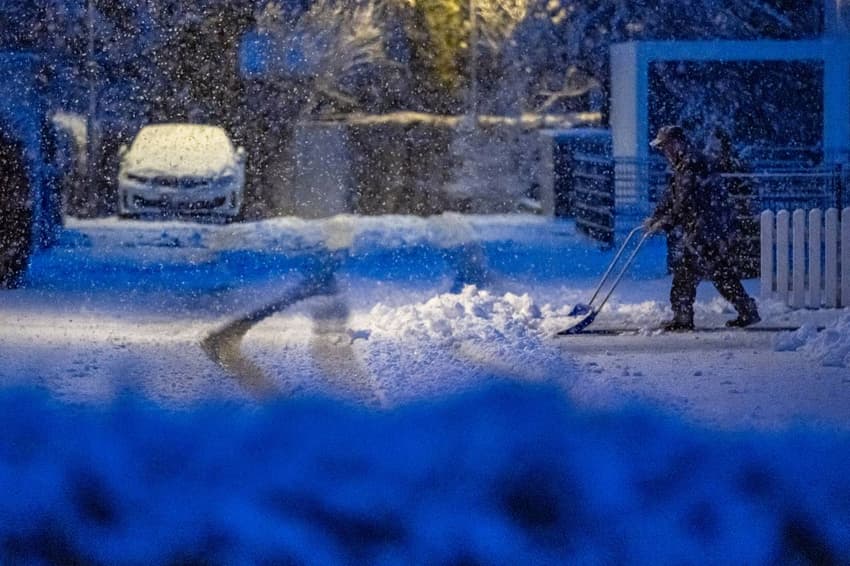Bavaria hit by severe snowstorms and gales

The German Weather Service (DWD) issued a severe weather warning in several parts of Bavaria on Thursday as the southern state was struck by heavy snowfall and 100km-per-hour winds.
The heavy snowfall and high winds, which began on Wednesday, caused multiple accidents and delays on roads overnight in several parts of the state, according to police.
Since the early hours of the morning, there were "considerable traffic obstructions throughout Lower Bavaria due to the weather", a spokesperson for the police said, adding that emergency services had been called out to around 100 incidents in the region.
"There have already been numerous traffic accidents and traffic disruptions due to the weather. Several vehicles have already had to be rescued from ditches and trees removed from the roadways."
The extreme weather is expected to continue on Thursday across southern and eastern Germany, with "no end in sight" to the heavy snowfall, according to DWD.
In districts near the Alps and the Bavarian Forest, gusts of up to 100 kilometres per hour and drifting snow are expected, meteorologists reported.
In the eastern districts and along the Alps, meanwhile, DWD has forecasted severe snowstorms and thunder. In parts of Franconia, Lower Bavaria and the Upper Palatinate, torrential rain will continue throughout Thursday and potentially lead to flooding.
On Thursday morning, DWD issued a stage 4 weather warning - the highest possible - for multiple districts in the state. Forecasters warned of icy roads, heavy downpours and thunderstorms throughout the day and into the evening.
Berchtesgadener Land, Rosenheim, Passau and Regensburg were among the 13 districts where warnings of severe storms were issued.
READ ALSO: IN PHOTOS: Germany hit by sudden snowstorms and temperatures as low as -10C
Drivers were urged to take caution on icy roads and DWD also warned of potential avalanches in mountainous areas where up to 1.5m of fresh snowfall was expected.
The rain and snow is set to die down on Friday, but freezing temperatures could lead to icy and slippery conditions for drivers.
Central and eastern German states - and parts of the Baltic coast - have also been experiencing turbulent storms in recent days, which meteorologists expect to last into Friday.
By the weekend, however, the high winds and stormy conditions are expected to have largely died down, with overcast skies, patchy rainfall and highs of around 11C.
Comments
See Also
The heavy snowfall and high winds, which began on Wednesday, caused multiple accidents and delays on roads overnight in several parts of the state, according to police.
Since the early hours of the morning, there were "considerable traffic obstructions throughout Lower Bavaria due to the weather", a spokesperson for the police said, adding that emergency services had been called out to around 100 incidents in the region.
"There have already been numerous traffic accidents and traffic disruptions due to the weather. Several vehicles have already had to be rescued from ditches and trees removed from the roadways."
The extreme weather is expected to continue on Thursday across southern and eastern Germany, with "no end in sight" to the heavy snowfall, according to DWD.
In districts near the Alps and the Bavarian Forest, gusts of up to 100 kilometres per hour and drifting snow are expected, meteorologists reported.
In the eastern districts and along the Alps, meanwhile, DWD has forecasted severe snowstorms and thunder. In parts of Franconia, Lower Bavaria and the Upper Palatinate, torrential rain will continue throughout Thursday and potentially lead to flooding.
On Thursday morning, DWD issued a stage 4 weather warning - the highest possible - for multiple districts in the state. Forecasters warned of icy roads, heavy downpours and thunderstorms throughout the day and into the evening.
Berchtesgadener Land, Rosenheim, Passau and Regensburg were among the 13 districts where warnings of severe storms were issued.
READ ALSO: IN PHOTOS: Germany hit by sudden snowstorms and temperatures as low as -10C
Drivers were urged to take caution on icy roads and DWD also warned of potential avalanches in mountainous areas where up to 1.5m of fresh snowfall was expected.
The rain and snow is set to die down on Friday, but freezing temperatures could lead to icy and slippery conditions for drivers.
Central and eastern German states - and parts of the Baltic coast - have also been experiencing turbulent storms in recent days, which meteorologists expect to last into Friday.
By the weekend, however, the high winds and stormy conditions are expected to have largely died down, with overcast skies, patchy rainfall and highs of around 11C.
Join the conversation in our comments section below. Share your own views and experience and if you have a question or suggestion for our journalists then email us at [email protected].
Please keep comments civil, constructive and on topic – and make sure to read our terms of use before getting involved.
Please log in here to leave a comment.